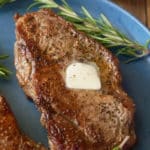
Pan Seared Steak (How to Cook Steak on the Stove)
Pan seared steak is the original fast food, cooked in a skillet and finished with butter, fresh herbs and garlic for extra flavor.
Servings 2
Calories 698kcal
Equipment
Ingredients
- 2 steaks (New York strip, ribeye, sirloin or Denver steak) cut 1-inch thick
- salt and freshly ground black pepper or steak seasoning
- 2 tablespoon olive oil
- 2 tablespoon unsalted butter
- fresh herbs such as thyme or rosemary
- garlic cloves minced - optional for flavor
Instructions
- Remove the steaks from the refrigerator, pat them dry, and season generously with salt and pepper on both sides. Allow them to sit out at room temperature for about 20 minutes.
- Meanwhile, heat a large skillet, cast-iron or stainless steel, over low heat for about 7 minutes. Then, increase the heat to medium-high and heat for an additional 3 minutes.
- Add the oil to the skillet, and swirl it to ensure the whole bottom of the skillet is covered.
- Lay one end of the steak into the part of the skillet that is closest to you, and slowly lower the rest into the skillet. Do this with other steak as well on the other side of the skillet. Make sure the steaks do not overlap or touch.
- Allow the steak to cook for about 3-4 minutes on the first side, then flip the steak and cook for an additional 3-4 minutes for medium-rare, or longer to your desired doneness (use a meat thermometer to check).
- In the last minute of cooking, add butter, herbs, and garlic to the pan for extra flavor. Tilt the pan and spoon the melted butter over the steaks.
- Transfer the steaks to a cutting board or plate and let them rest for about 5-10 minutes before slicing. This allows the juices to redistribute throughout the meat.
- Slice against the grain and serve immediately, optionally drizzling any pan juices over the top.
Notes
- This method works best steaks that are about 1-1 ¼ inch thick. Any thicker than that, and you will need to place your steaks in the oven to finish cooking.
- It’s best to use a cast-iron or stainless steel skillet when pan-searing steak. A non-stick skillet may not get the same crust as the other kinds will.
- When searing steak, I suggest you turn on the exhaust fan in the kitchen.
- It’s best to use a meat thermometer, such as a quick read thermometer, or a probe thermometer, to ensure steak is cooked to desired doneness. I like to remove steaks when they are about 5 degrees below my desired cooking temperature.
- Starting on low and increasing to medium-high allows for even heating and precise temperature control of the skillet.
Nutrition
Calories: 698kcal | Carbohydrates: 1g | Protein: 46g | Fat: 57g | Saturated Fat: 23g | Polyunsaturated Fat: 3g | Monounsaturated Fat: 28g | Trans Fat: 0.5g | Cholesterol: 168mg | Sodium: 1285mg | Potassium: 643mg | Fiber: 0.2g | Sugar: 0.1g | Vitamin A: 805IU | Vitamin C: 7mg | Calcium: 30mg | Iron: 4mg